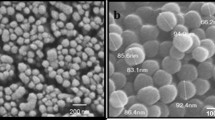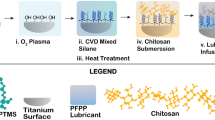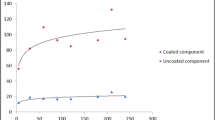Abstract
The surface of nickel-free high-nitrogen stainless steel (HNS) was modified with a citric acid-based cross-linker, trisuccinimidyl citrate (TSC), to promote initial cell adhesion in external skeletal fixation pins. The remaining active ester groups on TSC-immobilized HNS reacted with the amino groups of serum proteins. The immobilized serum proteins formed cell recognition sites to promote the initial cell adhesion immediately after cell seeding. The amount of fibronectin, which is a typical cell adhesion protein, immobilized on the TSC-immobilized HNS surface was threefold greater than on the original HNS after only 15 min. The fibroblastic cell culture experiments showed that the initial cell adhesion was significantly enhanced on the TSC-immobilized HNS compared with the original HNS at 3 h. Furthermore, the cell adhesion activity of the TSC-immobilized HNS continued to promote cell proliferation even at 7 days. Therefore, TSC-immobilized HNS may enable the rapid integration of soft tissues through its reaction with the patient’s serum proteins and extracellular proteins around the surgical site.





Similar content being viewed by others
References
Moroni A, Orienti L, Stea S, Visentin M, Giannini S. Hydroxyapatite coated stainless-steel external fixation pins. Mater Sci Forum. 1997;250:231–8.
Pieske O, Geleng P, Zaspel J, Piltz S. Titanium alloy pins versus stainless steel pins in external fixation at the wrist a randomized prospective study. J Trauma Inj Infect Crit Care. 2008;64:1275–80.
Mahan J, Seligson D, Henry SL, Hynes P, Dobbins J. Factors in pin tract infections. Orthopedics. 1991;14:305–8.
Bosetti M, Masse A, Tobin E, Cannas M. Silver coated materials for external fixation devices: in vitro biocompatibility and genotoxicity. Biomaterials. 2002;23:887–92.
Parameswaran AD, Roberts CS, Seligson D, Voor M. Pin tract infection with contemporary external fixation: how much of a problem? J Orthop Trauma. 2003;17:503–7.
Darouiche RO. Treatment of infections associated with surgical implants. N Engl J Med. 2004;350:1422–9.
Mutsuzaki H, Ito A, Sakane M, Sogo Y, Oyane A, Ochiai N. Fibroblast growth factor-2-apatite composite layers on titanium screws to reduce pin tract infection rate. J Biomed Mater Res B. 2008;86:365–74.
Lebaron RG, Athanasiou KA. Extracellular matrix cell adhesion peptides: functional applications in orthopedic materials. Tissue Eng. 2000;6:85–103.
Sasaki M, Inoue M, Katada Y, Taguchi T. The effect of VEGF-immobilized nickel-free high-nitrogen stainless steel on viability and proliferation of vascular endothelial cells. Colloid Surf B Biointerfaces. 2012;92:1–8.
Taguchi T, Saito H, Iwasashi M, Sakane M, Ochiai N. Biodegradable adhesives composed of human serum albumin and organic acid-based crosslinkers with active ester groups. J Bioact Compat Polym. 2009;24:546–59.
Inoue M, Sasaki M, Taguchi T. Unusual degradation behavior of citric acid-crosslinked gelatin in vitro and in vivo. Polym Degrad Stab. 2010;95:2088–92.
Inoue M, Sasaki M, Katada Y, Taguchi T. UV irradiation enhances the bonding strength between citric acid-crosslinked gelatin and stainless steel. Colloid Surf B Biointerfaces. 2011;88:260–4.
Sagara M, Uno H, Katada Y, Kodama T. Effect of alloy elements on localized corrosion characteristics of nitrogen-bearing stainless steels and evaluation of crevice corrosion in seawater environment. Tetsu To Hagane-J Iron Steel Inst Jpn. 2002;88:672–7.
Katada Y, Sagara M, Kobayashi Y, Kodama T. Fabrication of high strength high nitrogen stainless steel with excellent corrosion resistance and its mechanical properties. Mater Manuf Process. 2004;19:19–30.
Maruyama N, Sanbe M, Katada Y, Kanazawa K. Fatigue property of nickel-free high nitrogen austenitic stainless steels in simulated body fluid. Mater Trans. 2009;50:2615–22.
Yang K, Ren Y. Nickel-free austenitic stainless steels for medical applications. Sci Technol Adv Mater. 2010;11:1–13.
Okazaki Y, Gotoh E, Manabe T, Kobayashi K. Comparison of metal concentrations in rat tibia tissues with various metallic implants. Biomaterials. 2004;25:5913–20.
Montanaro L, Cervellati M, Campoccia D, Arciola CR. Promising in vitro performances of a new nickel-free stainless steel. J Mater Sci Mater Med. 2006;17:267–75.
Reclaru L, Ziegenhagen R, Eschler PY, Blatter A, Lemaitre J. Comparative corrosion study of “Ni-free” austenitic stainless steels in view of medical applications. Acta Biomater. 2006;2:433–44.
Wataha JC, O’Dell NL, Singh BB, Ghazi M, Whitford GM, Lockwood PE. Relating nickel-induced tissue inflammation to nickel release in vivo. J Biomed Mater Res. 2001;58:537–44.
Schmidt M, Raghavan B, Müller V, Vogl T, Fejer G, Tchaptchet S, et al. Crucial role for human Toll-like receptor 4 in the development of contact allergy to nickel. Nat Immunol. 2010;11:814–9.
Fini M, Aldini NN, Torricelli P, Giavaresi G, Borsari V, Lenger H, et al. A new austenitic stainless steel with negligible nickel content: an in vitro and in vivo comparative investigation. Biomaterials. 2003;24:4929–39.
Ren Y, Yang K, Zhang B, Wang Y, Liang Y. Nickel-free stainless steel for medical applications. J Mater Sci Technol. 2004;20:571–3.
Yamamoto A, Kohyama Y, Kuroda D, Hanawa T. Cytocompatibility evaluation of Ni-free stainless steel manufactured by nitrogen adsorption treatment. Mater Sci Eng C Mater Biol Appl. 2004;24:737–43.
Wang R, Hashimoto K, Fujishima A, Chikuni M, Kojima E, Kitamura A, et al. Light-induced amphiphilic surfaces. Nature. 1997;388:431–2.
Nosaka A, Kojima E, Fujiwara T, Yagi H, Akutsu H, Nosaka Y. Photoinduced changes of adsorbed water on a TiO2 photocatalytic film as studied by 1H NMR spectroscopy. J Phys Chem B. 2003;107:12042–4.
Uosaki K, Yano T, Nihonyanagi S. Interfacial water structure at as-prepared and UV-induced hydrophilic TiO2 surfaces studied by sum frequency generation spectroscopy and quartz crystal microbalance. J Phys Chem B. 2004;108:19086–8.
Ng SP, Billings KS, Ohashi T, Allen MD, Best RB, Randles LG, Erickson HP, Clarke J. Designing an extracellular matrix protein with enhanced mechanical stability. Proc Natl Acad Sci USA. 2007;104:9633–7.
Sasaki M, Inoue M, Katada Y, Nishida Y, Taniguchi A, Hiromoto S, Taguchi T. Preparation and biological evaluation of hydroxyapatite-coated nickel-free high-nitrogen stainless steel. Sci Technol Adv Mater. 2012;13:064213.
Ruoslahti E, Pierschbacher MD. New perspectives in cell adhesion: RGD and integrins. Science. 1987;238:491–7.
Grinnell F. Fibroblasts, myofibroblasts, and wound contraction. J Cell Biol. 1994;124:401–4.
Ito Y. Covalently immobilized biosignal molecule materials for tissue engineering. Soft Matter. 2008;4:46–56.
Park YS, Ito Y. Micropattern-immobilization of heparin to regulate cell growth with fibroblast growth factor. Cytotechnology. 2000;33:117–22.
Ma Q, Mei S, Ji K, Zhang Y, Chu PK. Immobilization of Ag nanoparticles/FGF-2 on a modified titanium implant surface and improved human gingival fibroblasts behavior. J Biomed Mater Res A. 2011;98:274–86.
Ragsdale SW. Nickel-based enzyme systems. J Biol Chem. 2009;284:18571–5.
Acknowledgments
We thank Ms. M. Ueno and Ms. T. Ishizuka of Biomaterials Unit, Nano-Life Field, National Institute for Materials Science of Japan, for technical support. This work was supported financially in part by the Japan Society for the Promotion of Science (JSPS) through the Funding Program for World-Leading Innovative R&D on Science and Technology (FIRST Program), initiated by the Council for Science and Technology Policy (CSTP), MANA, and the World Premier International Research Center (WPI) Initiative on Materials Nanoarchitectonics, MEXT, Japan.
Author information
Authors and Affiliations
Corresponding author
Rights and permissions
About this article
Cite this article
Sasaki, M., Inoue, M., Katada, Y. et al. Promotion of initial cell adhesion on trisuccinimidyl citrate-modified nickel-free high-nitrogen stainless steel. J Mater Sci: Mater Med 24, 951–958 (2013). https://doi.org/10.1007/s10856-012-4845-6
Received:
Accepted:
Published:
Issue Date:
DOI: https://doi.org/10.1007/s10856-012-4845-6




